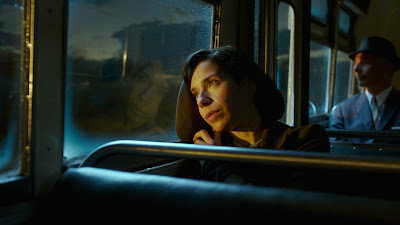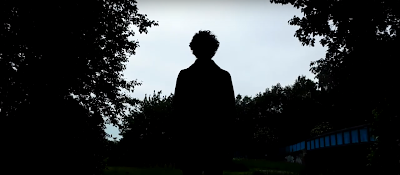The Shape of Water
The Shape of Water - The Shape of Love
What is it to be human? Is it to belong to the homo sapiens species? Or is it something more? Something deeper, something less superficial and scientific? Is it, perhaps, love? This is the question raised by this marvelous and lovely tale, titled The Shape of Water. Guillermo del Toro guides us through this dream of love and loss with such humanism and immerses us into an extraordinary world. We are immediately submerged in this magical world by the fantastic musical score of Alexandre Desplat. We dive into a magical world populated by fantastic sea creatures and terrible monsters, during the 60's, in the heat of the Cold War, all through the muteness of a princess without a voice but with a heart greater than most, who falls for a lost soul, victim of the injustices of power and greed of the world.
This princess without a voice is Elisa Esposito (a name associated with orphans), played by Sally Hawkins in one of her best performances so far. She lives in a small apartment over a cinema theatre that nobody goes to anymore. She works in a government research facility as a janitor, during the night. There she meets a strange aquatic creature that is being held captive. She starts to form a unique friendship with him, bonding over sign language, music and dancing. But there are evil forces that want to destroy this beautiful creature, ignoring the humanity and intelligence present in him. And so, Elisa must save this creature from the senseless monsters of the world.
These monsters are human beings, yet they are less human than the creature they want to destroy. And it's here where the big question of the film is raised: What makes us human?
All throughout the film, I kept thinking about an ancient Greek myth about the origins of love: at the beginning of time, humans had 4 sets of arms, 4 sets of legs and 2 faces. The gods, fearful of their power, decided to cut them in two, separating them into two human beings and dooming them to an eternal search for the other half, doomed to feel incomplete until they find their true love. Every character in The Shape of Water is trying to find this love. They are all, in a way, incomplete. And this is what makes them human. They are lonely and helplessly trying to quench that feeling and trying to fill their incompleteness - isn't this what moves all humans?
Elisa is a lonely mute woman that is in a disadvantaged position in society because of her disability. When people see her, they don't see a human being - at least they don't see her like other non-mutes. And so, she craves to be accepted and seen for what she truly is, with no judgements based on what is superficial in her. The creature - who is also lonely, in an aggressive world and mute - sees her for what she is and doesn't judge her. This is where their relationship blossoms. Elisa teaches him sign language and shows him music and they bond, with no judgments, simply as two humans - two beings capable of loving and in an equal standing, with no one superior to the other. That's why there is a certain scene - that is due to become one of the most iconic in cinema history - where Elisa fills her bathroom with water so that she can be in an equal environment and equal standing with the creature.
A remarkably interesting aspect of this film is that it shows the lives of the oppressed and outcast of society and it sheds a light on their lives. The film is mostly set at night, mostly because that's when Elisa goes to work, but also because at night is the only time when the outcasts of society can move freely and try to quench their longing for something they miss deeply, to quench their loneliness, to quench their loveless lives. When Elisa exits her apartment to go to work, we get a glimpse of various figures that society tries to hide. All throughout the movie, there are moments that appear, almost like slaps to our faces, that show a part of society that is constantly being concealed by it - the Civil Rights Protests, racial discrimination, sexual harassment in the workplace, homophobia. Every one of the main characters (except, the villain) is part of an oppressed group of people. Elisa is mute, Giles (her neighbour and best friend) is gay and has a job that is slowly being replaced by an advancement in technology (it's interesting that it's always the people in lower classes that are affected by this), Zelda (her colleague and best friend too) is black, and the creature, who could be used as an allegory for any group oppressed by the greed of the powerful. All these characters are written with dignity and humanity. They aren't stereotypes or progressist tokens in the screenplay of the film. And this is one of the great highlights of this movie - the humanity given to each character.
Yet, there is a character that has what could be called "a perfect life" - Richard Strickland, the main villain. He has a very traditional family - a wife, a son and a daughter - a good job, a nice house in a nice suburb and a nice American car. This character is the true monster of the story. This is one of the most interesting aspects of this story - the bad guy is the privileged rich white man, a man that has everything anyone could ever ask for and yet wants more and more - because nothing is ever enough to the human beings - using other people to get to his goal and with no consideration for their humanity. He represents the bad side of being human - the greed, the selfishness, and the excessive ambition. This perfect life that he has is also very fake and loveless. This is evidenced in his relationship with his wife - and more specifically in a sex scene that has a very disturbing violence (a big contrast with the relationship between Elisa and the creature).
And so, this film is not only about what makes us human but also about the outcast, the forgotten and the oppressed of society and their struggle against a privileged power that wants to subjugate them and throw them away when they seize to be useful.
Another interesting aspect is that imagination plays a big role in this film. There are things that are left to our imagination to connect the dots or simply imagine what happened. This is most evident at the end of the film. The movie ends in what may be perceived as a fairy tale ending. But that is not what happens. What happens is that the future is left to our imagination. The last image we see is Elisa and the creature finally united as one - like the ancient Greek myth. We hear the narration of Giles. He asks if they will live happily ever after, were they in love and would they remain in love. And that's what is left to our imagination.
Will they live happily ever after? Are they in love? Will they remain in love? We don't know, but we hope they will.
The relationship between Elisa and the creature may seem strange at first but we end up falling in love with them - as they did with each other - and empathising with their relationship. This is because being human is not restricted to biology. Being human has to do with love and empathy. That is what makes us human. That is what makes the creature human. The Shape of Water is a questioning of what is being human, and it reveals its answer in the shape of love.




Comments
Post a Comment